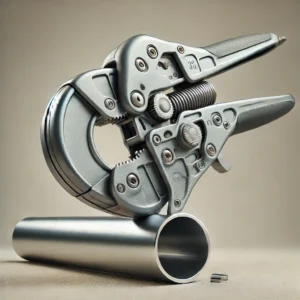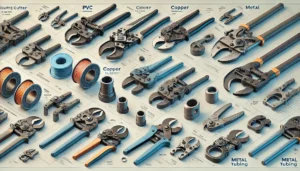The Full Overview to Tubing Cutter:
Kinds, Makes usage of, and Just How to Pick the Right One
What is a Tubing Cutter?

This is essential for keeping the stability of the tubing, particularly in applications where securing or threading is called for. Missing the deburring action is an additional usual blunder
Types of Tubing Cutters:

Standard Tubing Cutters
- Design: Features a circular cutting blade and rollers to grip the tube.
- Best For: Copper, aluminum, and thin-walled steel tubing.
- How It Works: The user tightens the cutter around the tubing, rotates it, and gradually increases pressure until the cut is complete.
Mini Tubing Cutters
- Design: Smaller version of the standard cutter for tight spaces.
- Best For: Working in confined areas like under sinks or behind walls.
- How It Works: Functions similarly to standard cutters but accommodates smaller diameters and restricted access.
Plastic Pipe Cutters
- Design: Scissor-like tool with a sharp blade for slicing through plastic tubing.
- Best For: PVC, CPVC, PEX, and other plastic pipes.
- How It Works: Apply pressure to the handles to slice through the pipe.
Ratchet Tubing Cutters
- Design: Uses a ratcheting mechanism for increased cutting force.
- Best For: Thick plastic pipes and tougher materials.
- How It Works: Squeeze the handles repeatedly to incrementally close the blade and cut through the tubing.
Powered Tubing Cutters
- Design: Electric or battery-powered for faster and more precise cutting.
- Best For: High-volume or heavy-duty cutting tasks.
- How It Works: The motor powers the blade, and the user guides the tool around the tubing.
Rotary Pipe Cutters
- Design: Heavy-duty tool with multiple cutting wheels.
- Best For: Steel and iron pipes.
- How It Works: Tighten the cutter and rotate it around the pipe to gradually cut through.
How to Use a Tubing Cutter:

Prepare the Tubing
- Ensure the tubing is clean and free of debris.
Mark the desired cutting point with a marker or pencil.
Set the Cutter
- Open the cutter to fit the tubing.
Position the cutting blade on the marked point.
Tighten the Cutter
- Adjust the cutter’s tightening mechanism until the blade lightly touches the tubing.
Rotate the Cutter
- Rotate the cutter around the tubing, applying steady pressure.
Gradually tighten the blade after every few rotations.
Complete the Cut
- Continue rotating until the tubing is cleanly severed.
Remove any burrs or rough edges using a deburring tool for a smooth finish.
Benefits of Using a Tubing Cutter:
- Precision: Provides clean and accurate cuts.
- Speed: Faster than using a saw or other cutting tools.
- Minimal Deformation: Preserves the round shape of the tubing.
- Ease of Use: Simple design makes it user-friendly.
- Durability: Designed to handle tough materials and frequent use.
Read About : Tubing Clamps
Tips for Choosing the Right Tubing Cutter:
Additional Features
Material Compatibility
- Match the cutter to the type of tubing you’re working with (e.g., metal or plastic).
Size Range
- Ensure the cutter accommodates the diameter of the tubing.
Ease of Use
- Consider features of tube cutters like ergonomic grips and ratcheting mechanisms for comfort and efficiency.
Portability
- For on-the-go tasks, choose compact or mini cutters.
Durability
- Some models include built-in deburring tools or adjustable cutting wheels for versatility.
- Opt for high-quality materials like stainless steel for longevity.
Maintenance Tips for Tubing Cutters :
- the Blade Sharp: Replace or hone the blade routinely to keep reducing performance.
- Tidy After Use: Remove particles and deposit to stop rust.
- Oil Moving Parts: Apply light oil to make sure smooth procedure.
- Shop Properly: Keep in a completely dry, secured location to stay clear of damages.
Common Mistakes to Avoid
- Over-Tightening : Applying too much pressure on tubing cutters when using a tubing cutter can lead to problems like bent tubing or even a damaged cutter or even injured yourself.
- Skipping the deburring step is another common mistake. Rough edges left on the tubing can affect its performance and even create safety issues.
- Using the wrong tool is also a big no-no. Always pick the right cutter for the material and size you’re working with to avoid unnecessary hassle or damage.
FAQS frequently asked:
What is the purpose of a tube-cutters?
- Tube cutters can be used for cutting tubes and pipes in a clean manner, typically when working on mechanical equipment or plumbing.
What is the purpose of the hose cutter?
- A hose cutter is used to cut the hose into desired length. The material is not damaged and the cut will be clean.
What is the best way to cut tube?
- Rotate the cutter to cut the tube. Place the tubing into the cutter and tighten the knob. As you tighten it, the tube will start to cut.
Is there another term for a tube cutter?
- A pipe cutter is another name for tubing cutters.
Which tool is used for cutting a tube?
- Tubing or pipe cutters are commonly used for cutting a tube.
Is there another term for a rotary cut?
- A wheel cutter is another name for a circular cutter.
Final thought:
Tubing cutters are essential devices for anybody dealing with pipelines or tubing. With numerous alternatives developed for various products and work, picking the best one can conserve you time, initiative, and stress. By complying with these straightforward suggestions, you’ll have the ability to make use of and take care of your tubing cutter effectively, making sure smooth and tidy cuts whenever.